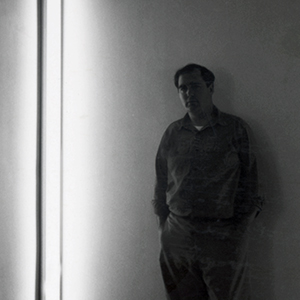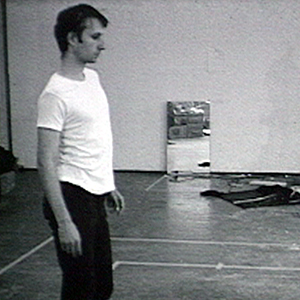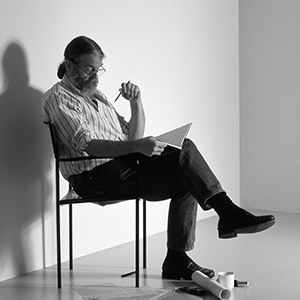
 Dan Flavin al lado de Pink out of a corner (to Jasper Johns), 1963, Green Gallery, Nueva York, 1964. � 2019 Stephen Flavin. � Artists Rights Society (ARS), New York / SAVA, Buenos Aires
Dan Flavin al lado de Pink out of a corner (to Jasper Johns), 1963, Green Gallery, Nueva York, 1964. � 2019 Stephen Flavin. � Artists Rights Society (ARS), New York / SAVA, Buenos Aires
DAN FLAVIN
Daniel “Dan” Nicholas Flavin Jr. (1933-1996) was a leading minimalist sculptor and installation artist who pioneered the use of commercial fluorescent light fixtures as a viable artistic material. Born in Jamaica, New York on April 1, 1933, Flavin was raised in a devoutly Catholic family. He spent five years at a Brooklyn seminary school—from 1947 to 1952—before deciding to forgo the priesthood and join his fraternal twin brother, David, in enlisting in the United States Air Force. Flavin began studying art during the Korean War through extension courses and briefly enrolled in the Hans Hofmann School of Fine Arts upon his return to New York in 1956. He would later study art history at the New School for Social Research along with painting and drawing at Columbia University. Yet perhaps most formative was his brief tenure as a guard and elevator operator at the Museum of Modern Art in the early 1960s. It was there that he met his first wife, art historian and artist Sonja Severdija, along with critic Lucy Lippard and fellow minimalist Sol LeWitt, all of whom would prove influential to the course of his career.
Flavin, like many of his contemporaries, started out as an Abstract Expressionist painter and draughtsman. In the summer of 1961, however, he alighted upon the radical idea to incorporate electric lightbulbs into his artwork; within several months he began making what he called “icons”—monochromatic paintings augmented with various types of incandescent and fluorescent bulbs. But these mixed media experiments only occupied him for a brief time. By 1963 Flavin’s focus had shifted exclusively to the visual, conceptual and compositional potential of off-the-shelf fluorescent lights. His first light bulb work, “May 25, 1963 (to Constantin Brancusi),” consisted of a single gold tube hung diagonally on a wall. The artist later went on to make many more diagonal compositions, demonstrating an interest in permutation that came to define his career and, more broadly, the minimal art movement as a whole. Much like Donald Judd, Richard Serra and other peers, Flavin embraced the technical constraints imposed by using industrial materials for the iterative potential it posed. Fluorescent lights were only commercially manufactured in standard lengths (two, four, six and eight feet) and specific colors (pink, red, green, blue, yellow, ultraviolet and four shades of white). Consequently, Flavin often explored the phenomenological differences between certain compositions when reimagined in slightly different tones and scales.
Ironically, despite his lionization as a leading minimalist sculptor, Flavin actually objected to both the terms “minimalism” and “sculpture.” He insisted that his works were neither reductive nor traditional but, instead, were complex spatial interventions that made them more akin to “situations” or “proposals.” As he later wrote: “the actual space of a room could be disrupted and played with by careful, thorough composition of the illuminating equipment.” Through the meticulous accumulation and manipulation of readymade lightbulbs, Flavin crafted works that suffused, segmented and distorted the galleries in which they were presented.
 Walking in an Exaggerated Manner Around the Perimeter of a Square, 1967-68 (Tocando una nota en el viol�n mientras camino por el estudo) Film 16 mm en video blanco y negro, con sonido / 10 Cortes�a Electronic Arts Intermix � Bruce Nauman / Artists Rights Society (ARS), New York / SAVA, Buenos Aires
Walking in an Exaggerated Manner Around the Perimeter of a Square, 1967-68 (Tocando una nota en el viol�n mientras camino por el estudo) Film 16 mm en video blanco y negro, con sonido / 10 Cortes�a Electronic Arts Intermix � Bruce Nauman / Artists Rights Society (ARS), New York / SAVA, Buenos Aires
BRUCE NAUMAN
For more than half a century Bruce Nauman (b. 1941) has made avant-garde artwork in nearly every possible medium, breaking down barriers between art, life and genre to become a paragon of the conceptualist and post-minimalist movements. Beyond his forays into sculpture, photography, printmaking and film, Nauman also pioneered the the use of many unorthodox materials, including handheld Portapak video cameras, surveillance equipment, television monitors, holograms and neon signs. Despite this diversity of output several common concerns prevail, chief among them Nauman’s practical and philosophical interest in the body, his experiments with space and perception, and his disruption of communication networks through the distortion of visual and linguistic signs. Above all, Nauman has remained a provocateur, crafting works whose endless duration, unsavory subject matter or invasive construction test the viewer’s physical, mental and emotional limits. The range and complexity of his work has earned him a reputation as a true “artist’s artist.”
Bruce Nauman was born on December 6, 1941 in Fort Wayne, Indiana; growing up, his father’s work as an engineer at General Electric meant Nauman and his family moved frequently. In 1960 Nauman enrolled in the University of Wisconsin at Madison to study mathematics and physics; he later changed his major to art, graduating in 1964. After college he began a Master’s of Fine Arts at the University of California at Davis, where he studied with sculptor Robert Arneson and multi-media artist William T. Wiley (who is often credited with inspiring Nauman’s lifelong devotion to wordplay). Although Nauman also served as a teaching assistant under famed pop painter Wayne Thiebaud during this period, he quickly excised painting from his own practice to focus on sculpture, performance and filmmaking.
After graduating from UC Davis in 1966 he supported himself by teaching at the San Francisco Art Institute (1966-1968) and the University of California at Irvine (1970). It was at this time that he moved into a vacant grocery store in San Francisco. Sequestered in the large, open space with copious time on his hands, he decided that anything he made or did in this makeshift ‘studio’ could and should be considered art. Playing off its commercial origins, he began designing neon signs to hang in the storefront window; his first neon piece—“The True Artist Helps the World by Revealing Mystic Truths” (1967)—can be read as half-mockery, half-testimony of his revolutionary artistic goals.
Perhaps the most groundbreaking body of work to emerge during this time, however, was Nauman’s now iconic experiments with film and video. Deadpan and often repetitious, these works recorded the artist’s odd experiments with his body—bouncing in a corner, pacing around a square, rhythmically goose-stepping—in seeming real time as the ideas occurred to him. Although his early works were recorded on 16mm film, by the late 1960s he had moved on to video, after receiving a handheld Portapak camera from his dealer, Leo Castelli. Nauman full took advantage of the malleability of the new technology, filming upside down and over longs periods (often the full sixty minute length of the video tape) to test the viewer’s perceptual flexibility and endurance.
It would not be long before his career took off. The prominent Los Angeles dealer Nicholas Wilder offered Nauman his first solo show in 1966 when the artist was only twenty-four; two years later both Leo Castelli and Konrad Fischer—major supporters of minimal art—would join suit. In 1968 he was also invited to participate in Documenta 4 and given a generous grant by the National Endowment for the Arts. His first solo museum exhibition was hosted by the Los Angeles County Museum of Art and the Whitney Museum of American Art in 1972; it later traveled across Europe and America. In 1979 Nauman moved to New Mexico, where he still resides.
As his career has progressed, Nauman’s work has taken on more disquieting themes and imagery. At the end of the 1960s he began making installations that incorporated constrictive corridors, isolated spaces and, eventually, surveillance cameras. Regularly combined with other jarring elements—such as too-bright neon lighting or droning industrial fans—these works foster an uneasy sense of dissociation and incarceration in even the busiest galleries. By the mid-1980s such installations became more sculptural and explicit. The result are massive, oscillating machines laden with casts of human and animal body parts, many of which are set to drag along the ground like roadkill. Even his videos sought to overwhelm with their scale and substance; works like “Clown Torture” (1987) assault visitors with loud, looping footage shown on multi-channel projections and monitors, engendering full sensory overload. One critic likened experiencing these works to “being split open by the relentless, repetitive drive of a jackhammer.”
Nauman’s recent work, however, has become more meditative, returning to his earliest, experimental projects like videotaping his exaggerated walks around the studio. Despite endless accolades—including honorary doctorates (1989, 2000), the Wexner Prize (1994) and the Venice Biennale’s Leone d’Oro (2009)—Nauman has eschewed the spotlight. He has spent the past forty years living and working in rural New Mexico; today he resides on a ranch in the small town of Galisteo with his wife, painter Susan Rothenberg.
 Fred Sandback en Magasin III Museum & Foundation for Contemporary Art (anteriormente Magasin 3 Stockholm Konsthall), 1991 Foto: Neil Goldstein
Fred Sandback en Magasin III Museum & Foundation for Contemporary Art (anteriormente Magasin 3 Stockholm Konsthall), 1991 Foto: Neil Goldstein
FRED SANDBACK
Fred Sandback (1943-2003) ) was a vital figure in the minimal and conceptual art movements, best known for his drawings, prints and sculptures made out of yarn.
Sandback was born in Bronxville, New York on August 29, 1943. As a young man, the artist was fascinated with anything strung. Early, formative experiences included learning how to make snowshoes and watching his uncle, an antique dealer, recane chairs. His interest in music led him to make his own banjos and dulcimers as a teenager. While working as a summer camp counselor in New Hampshire he became an expert archer and taught himself how to string bows.
Sandback attended college at Yale University, graduating in 1966 with a bachelors degree in philosophy, before continuing on to receive his master’s at Yale’s School of Art in 1969. There he studied sculpture and was highly influenced by visiting instructors Donald Judd and Robert Morris—two towering figures in the minimal art movement.
In 1967, while working in his basement studio at Yale, Sandback created his first mature work. Playing with volume and void, the artist outlined the shape of a two-by-four wooden board lying on the floor using only elastic cord and metal rod. Even after the board was removed its ghostly presence remained, communicating, as the artist would later explain, “[a] full materiality without occupying and obscuring,” the demarcated space.
Eager to push his work to its dematerialized limits, Sandback soon ceased making sculpture with metal rods and elastic cord, favoring instead the ready flexibility, availability and color palette of humble acrylic yarn. His work began to interact with its environment, relying in the architecture of a given space to expand or contract the piece before the viewer’s eyes.
Unsurprisingly, Sandback was a prolific printmaker. Eventually Sandback saw them as a compelling forum for experimentation all their own. The artist thereby experimented with a wide variety of papers and mediums, including etching, engraving, linocut, silkscreen, and lithography.
Sandback’s devotion to the line in its many material forms garnered him many admirers and much critical attention over the course of his career. The artist was invited to install several sculptures in Donald Judd’s New York studio in 1968. Within the year Sandback was granted solo exhibitions across Germany—where conceptual art was king—and was included in major group exhibitions in Europe and New York.
In the summer of 1977 he was allotted 10,000 square feet of space in MoMA’s contemporary art outpost, P.S.1, to use as his own personal studio for about a month. The vast building gave Sandback the rare opportunity to test out an exponential increase in scale; space constraints in both commercial galleries and his own studio had thus far prevented him from making more than one work at a time. At P.S.1 Sandback formalized a visual lexicon—stringing yarn floor-to-ceiling or wall-to-wall—that would later prove exceptionally well-suited to exhibition in the cavernous galleries of twenty-first century contemporary art museums.
Consequently, Sandback was one of a select number of minimal, conceptual and post-minimal artists supported by the Dia Art Foundation. In 1981 Dia opened The Fred Sandback Museum in Winchendon, Massachusetts. Being connected to the gallery’s floors, walls and ceilings, Sandback’s sculptures typically required being removed after every exhibition. He died on June 23, 2003 in New York City when he was 59 years old.